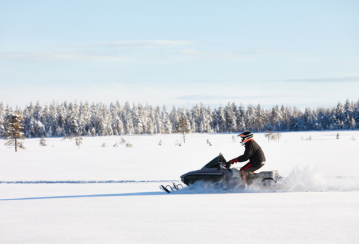News and Updates
10 essential off-road vehicle and snowmobile safety tips
Off-road vehicles and snowmobiles are popular forms of recreation for many Ontarians. Depending on your location, they’re also necessary for transportation in remote areas and emergencies. Nevertheless, these vehicles aren’t toys. If you intend to drive one, take note of the following safety tips before you hit the trails.
-
Review the local laws
If you’re new to operating an off-road vehicle or snowmobile or just need a refresher on the rules, take some time to review the provincial and regional laws. You cannot drive an off-road vehicle or snowmobile on most public roads in Ontario, but some exceptions exist.1 For a complete list of off-road vehicle- and snowmobile-related laws, refer to the Highway Traffic Act, the Off-road Vehicles Act, and the Motorized Snow Vehicles Act of Ontario.
-
Check the weather forecast
Check the local weather forecast and ice conditions before heading out. If freezing rain or a blizzard is on the horizon, you’re better off cozying up inside and saving your ride for another day.
-
Inspect your vehicle
Before every trip, inspect your off-road vehicle or snowmobile to ensure everything is in good working order. Your life may depend upon it. Double-check your tank’s fuel level and confirm that your emergency kit is fully stocked.1 Read your owner’s manual carefully, and always keep it with your vehicle.
-
Wear the proper safety gear
You must wear a helmet when driving or riding on an off-road vehicle or snowmobile.1 The only exception is when you operate the vehicle on your land, but wearing one for safety is still highly recommended.1 Your helmet must meet the standards approved for motorcycle or motor-assisted bicycle helmets and be appropriately fastened under your chin.1 In addition to a helmet, the Government of Ontario advises that you equip yourself with a face shield or goggles to protect your eyes.
-
Dress for success
Dress in layers to protect yourself against prolonged exposure to cold wind-chill temperatures.1 Outer layers should be waterproof and well-insulated, and inner layers should be made from moisture-wicking fabric. Avoid naturally absorbent materials like cotton, as they can make you colder if they get wet. If you snowmobile often, consider purchasing a buoyant snowmobile suit, especially if you travel over frozen lakes and rivers.1
-
Plan your route
Before you ride, always take some time to plan your route and share it with a trusted family member or friend who can call for help if you don’t return as planned.1 Consider turning on your mobile phone’s location-sharing settings to allow your family member or friend to keep track of your location throughout your trip. Use the buddy system, and drive your off-road vehicle or snowmobile within your abilities and according to conditions.1
-
Stay sober
Operating an off-road vehicle or snowmobile while under the influence of alcohol or drugs is dangerous and against the law.1 Drivers found to be impaired by alcohol or drugs will be charged under the Criminal Code.1 If convicted, you could lose your driving privileges for all types of vehicles.1
-
Stick to public trails
Ontario has many established and maintained public trails patrolled by various law enforcement agencies.1 Some trails require that you have and display a trail permit to drive on them.1 For more information about trails and trail permits, visit the Ontario Federation of Snowmobile Clubs' website.
It's strongly recommended that drivers avoid crossing frozen bodies of water.1 However, if you absolutely must venture onto ice, be sure you've reviewed the Canadian Council of Snowmobile Organizations' Ice Smart Safety Tips beforehand.
-
Obey the rules of the road
Just like with any vehicle, too much speed can lead to trouble. If you follow the speed limit – or slower in poor conditions – you’ll have better traction and more control. Speed limits for off-road vehicles and snowmobiles vary depending on your location, so be sure to research municipal bylaws ahead of time.1 Familiarize yourself with the correct hand signals and when to use them to tell others what you want to do and give them a chance to slow down or stop.1
-
Carry your proof of insurance with you
If you plan on buying a new off-road vehicle or snowmobile, remember that it must be registered and insured to drive it off your property.1 Carry your insurance card with you every time you ride in public areas and show it when a police or conservation officer asks for it.1
Insurance for your off-road vehicle or snowmobile
Sometimes accidents happen, even when you obey the rules and do your due diligence, but that’s what insurance is for! The most common types of coverage you may find in your policy are:
-
Accident benefits coverage
-
Collision coverage
-
Comprehensive coverage
-
Third-party liability coverage
Ontario requires liability insurance coverage to drive your off-road vehicle or snowmobile off your property.1 Still, you may want to increase your limits to ensure you have enough protection in the event of an accident. Depending on your insurer, you may want to consider additional optional coverage for your riding gear.
If you're a current OTIP policyholder, contact us at 1-833-494-0089 to review your existing auto insurance policy to add coverage for your off-road vehicle or snowmobile. If you're not insured with OTIP and are shopping for off-road vehicle or snowmobile insurance, call us at 1-833-615-9326 to get a quote and receive a $20 gift card of your choice!







